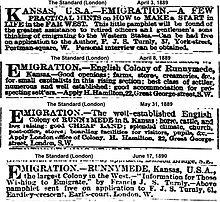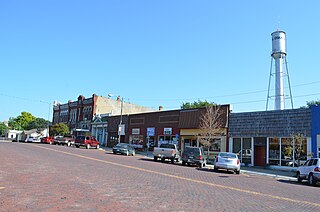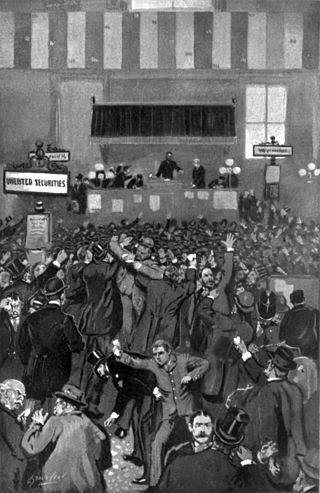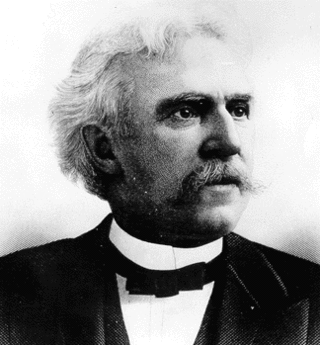
Runnymede is an unincorporated community in Harper County, Kansas, United States. [1] It is located northeast of Harper along K-2 state highway at the intersection of NE 140 Rd and NE 60 Ave.

Runnymede is an unincorporated community in Harper County, Kansas, United States. [1] It is located northeast of Harper along K-2 state highway at the intersection of NE 140 Rd and NE 60 Ave.

Runnymede was touted by an Irish promoter as a planned community in Kansas to wealthy Irish and Great British families in the United Kingdom as a place in a "dry" state where their sons could come to begin a career as gentlemen farmers. Begun in 1888, the speculative though impressive scheme essentially collapsed within four years. The livery stable burned down in 1890. Other buildings were moved two miles (3.2 km) south close to the new constructed rail line. In 1891, the centerpiece of the town, a hotel, was partly disassembled and moved into the recently opened Cherokee Strip in Alva, Oklahoma in 1893. It remains in use there today, thanks to a successful local effort at restoration. [2] Runnymede's church was moved to Harper, Kansas in 1893, where it now serves as a museum.
A post office was opened in Runnymede in 1879, and remained in operation until it was discontinued in 1944. [3]
The community was named after Runnymede in England. [4]
William Desmond Taylor joined the Runnymede community in August 1891. [5]
The community is served by Chaparral USD 361 public school district.

John Brown was a prominent leader in the American abolitionist movement in the decades preceding the Civil War. First reaching national prominence in the 1850s for his radical abolitionism and fighting in Bleeding Kansas, Brown was captured, tried, and executed by the Commonwealth of Virginia for a raid and incitement of a slave rebellion at Harpers Ferry in 1859.

Morris County is a county located in the U.S. state of Kansas. Its county seat and largest city is Council Grove. As of the 2020 census, the county population was 5,386. The county was named for Thomas Morris, a U.S. Senator from Ohio and anti-slavery advocate.

Marion County is a county located in the U.S. state of Kansas. Its county seat is Marion and its most populous city is Hillsboro. As of the 2020 census, the county population was 11,823. The county was named in honor of Francis Marion, a brigadier general of the American Revolutionary War, known as the "Swamp Fox".

Chase County is a county located in the U.S. state of Kansas. Its county seat and most populous city is Cottonwood Falls. As of the 2020 census, the county population was 2,572. The county was named for Salmon Chase, a U.S. Senator from Ohio that was a Kansas statehood advocate.

Strong City is a city in Chase County, Kansas, United States. Originally known as Cottonwood Station, in 1881 it was renamed Strong City after William Barstow Strong, then vice-president and general manager, and later president of the Atchison, Topeka and Santa Fe Railway. As of the 2020 census, the population of the city was 386. It is located along U.S. Route 50 highway.

Oskaloosa is a city in and the county seat of Jefferson County, Kansas, United States. As of the 2020 census, the population of the city was 1,110.

The Panic of 1893 was an economic depression in the United States that began in 1893 and ended in 1897. It deeply affected every sector of the economy and produced political upheaval that led to the political realignment of 1896 and the presidency of William McKinley.

Elijah E. Myers was a leading architect of government buildings in the latter half of the 19th century, and the only architect to design the capitol buildings of three U.S. states, the Michigan State Capitol, the Texas State Capitol, and the Colorado State Capitol. He also designed buildings in Mexico and Brazil. Myers' designs favored Victorian Gothic and Neo-Classical styles, but he worked in other styles as well.

The Kansas House of Representatives is the lower house of the legislature of the U.S. state of Kansas. Composed of 125 state representatives from districts with roughly equal populations of at least 19,000, its members are responsible for crafting and voting on legislation, helping to create a state budget, and legislative oversight over state agencies. Representatives are elected to two-year terms. The Kansas House of Representatives does not have term limits. The legislative session convenes at the Kansas State Capitol in Topeka annually.
The Enid News & Eagle is a daily newspaper published Tuesday through Sunday in Enid, Oklahoma, United States. The publication covers several counties in northwest Oklahoma and is owned by Community Newspaper Holdings Inc. The newspaper also provides regularly updated news coverage at enidnews.com.
Huscher is an unincorporated community in Cloud County, Kansas, United States.
Anness is an unincorporated community in Sedgwick County, Kansas, United States, about 4.75 miles west of Viola, between W 111th St S and W 119th St S, and between S 327th St W and S 343rd St W.

The Kansas Historical Society is the official state historical society of Kansas.
During the Civil War, Coldwater Grove existed 131⁄2 miles east of Paola, Kansas, in Miami County. It straddled the Kansas-Missouri border, being partly in both states. About June 1863 a Union military post was established on the Kansas side of the community and the post was put under the command of Lt. Col. Charles S. Clark. Clark also commanded four nearby posts.
Council Grove's Post is a trading post on the Santa Fe Trail that operated in Council Grove, Kansas. It was established around 1861 and decommissioned around 1864, with ties to the Civil War.
In 1864 Gen. Samuel R. Curtis established a military camp at the Fort Riley-Fort Larned Road crossing of the Smoky Hill River in what is now Ellsworth County, Kans.
Fort Lincoln was established about August 24, 1861, by United States Senator James Lane. Earlier in August, Lane had reestablished Fort Scott as a military post. Soon Confederate troops under Maj. Gen. Sterling Price threatened to overrun the newly reopened post.

Alexander Miller Harvey was an American lawyer, politician, and author.

Furley is an unincorporated community in Sedgwick County, Kansas, United States. As of the 2020 census, the population of the community and nearby areas was 39. It is located northwest of the intersection of Greenwich Road and 101st Street N, along the Union Pacific Railroad.
Darlow is an unincorporated community in Lincoln Township, Reno County, Kansas, United States. It is located several miles west of Yoder along Red Rock Road.
{{cite web}}: CS1 maint: unfit URL (link)37°21′23″N97°55′47″W / 37.35639°N 97.92972°W